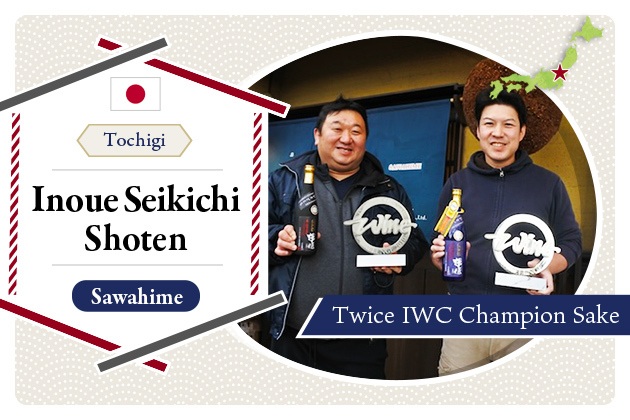
2020.03
16
The finishing touch! Ways in which pressing shapes the sake
Sake does not have that transparency you are probably used to seeing when it has freshly been brewed. It is only once the "moromi", a resulting product of rice, koji and water fermented by yeast, has been squeezed that you are left with sake-kasu (sake lees) and… sake!
This process of separating the sake and sake-kasu is called "joso", and it involves placing moromi from fermentation into bags and applying pressure until it separates into sake and sake-kasu. The term joso originates from when all the breweries would use a vat called "fune(槽)" in Japanese, to squeeze the liquor, that makes up the second character in joso(上槽).
The word joso is generally used without specifying the exact method. However, many variations ranging from the traditional to modern techniques only used in a handful of breweries, all the way to a revolutionary patented method exist. Here we will take a closer look at terms like "funa-shibori" and "fukuro-tsuri" that you might have only glanced over before.
Squeezing methods and their characteristics
Three ways of using a vat
Firstly, we begin by looking at three ways that use the vat mentioned earlier. Since the invention of the Yabuta style automatic filter press machine in the 1960’s, the usage of vats temporarily waned. However, it has started making a comeback in some breweries, as its quality is considered to be better. The fune can mean any vessel-shaped device used for pressing alcohol, with various materials, shapes, and sizes existing according to the pressing method.
Sase method
The first is the Sase method, the most common of vat pressing today. The "vat" used is like the one in the image. The material used to be of zelkova and ginkgo hardwood, but has since evolved to concrete and enamel, and is now made of iron with a stainless-steel plate attached inside.
Inside this vat, long sake bags made of a thick textile are filled with moromi and stacked carefully. At first, the moromi is pressed by its own weight until halfway through when the machine is used to apply further pressure. This is called the Sase method vat press (funa-shibori). A lot of manpower is needed to fill the bags with moromi and stack them, making it a very labor-intensive method. However, it is free from any excessive use of pressure, producing a fine quality sake, gentle on the lips, with a clear taste.
Yaegaki method
The second is the Yaegaki method. The vat is like the one shown above and is shallower than the Sase method. On top of this vat, bags the same size as the vat and aluminum plates are stacked alternately. A pump then pushes moromi into these bags, working from bottom to top. From here, same as the Sase method, the moromi is first pressed using its own weight, followed by additional pressure from the machine.
The application of pressure is like the Sase method. However, while the Sase method presses the moromi directly within the walls of the vat, the Yaegaki method presses from above the vat, that is, from the outside and therefore increases exposure to the air. Nowadays, in a quest for fresher sake, some go through the lengths of chilling the pressing facilities or trying to reduce the exposure to air. However, the Yaegaki method takes a contrarian approach and allows the moromi to be aired, in order to help oxidization. The resulting pressed product is a mellow and unique sake indeed.
Hane-ki method
The third is the hane-ki method. The two earlier methods utilize the power of a machine to press, but this one only uses manpower for the entire press.
The "vat" used is not all that different from the Sase method. Just like in the Sase method, sake bags filled with moromi are stacked inside the deep vat and the lid is closed. Above it, a huge tree log (the hane-ki) is placed, and using the principles of a lever, the weight of the stones at the end is converted into pressure on the vat. This method is known as the hane-ki shibori or tenbin-shibori (literally, "balance press"). Sake that is slowly pressed using different pressures adjusted by hand, tends to have a more mellow and fuller taste than that pressed by machines.
Using the Yabuta style automatic filter press machine
Next, we introduce the Yabuta style automatic filter press machine (commonly called Yabuta). The entire machine looks as shown in the image above, and it is inside the white section that moromi is pumped. This part is made from alternating filtration and pressure panels for the moromi. From here, pressure is applied from the sides.
The many advantages compared to vat pressing include:
- Reduction in press time by more than half. As a result, the exposure to air is limited, thus enhancing the quality.
- Reduced burden on brewery workers given automation from pumping the moromi to pressing.
- Increased sake output from stronger pressure being applied compared to vat pressing.
At the beginning, the practical advantages were unfortunately traded for slightly poorer quality in taste since too much pressure was being applied. However, this is not a problem nowadays. In addition to the original advantage of being able to press sake over a shorter time, by placing the Yabuta directly in a refrigerator and pressing the moromi at a continued low temperature, the carbonated gas from the fermentation can be trapped to keep a fresh and clear taste in the sake.
Fukuro-tsuri (hanging bag)
The methods described up until now, have used machines and tools to lighten the human burden to varying degrees. Next, we describe a method that spares no labour to produce good sake – fukuro-tsuri (literally, "bag hang") or shizuku-tsuri (literally, "dew hang").
This method basically has a beam over a receptor to hang bagful of moromi, allowing as little space as possible in-between the bags to limit air exposure. With no application of pressure whatsoever, the bags are left for the sake to drip naturally.
The amount of moromi that can be pressed in any one time is small, and because no pressure is applied, the process takes patience and is even inefficient as the last drops are not squeezed from the moromi. However, it limits oxidation and is even said to be the most ideal method. In tandem, any un-pressed moromi is transferred into any of the vat pressed methods described previously. It is a method reserved for sake to be presented at exhibitions and although not widely circulated, it is a wonderful sake that draws on the best of the brewery's techniques.
Centrifuge
From here, we will look at less commonly used methods that use the latest equipment and technology.
The first is using centrifuge. The one depicted above is the latest one, used by less than twenty companies domestically. The moromi is placed in the machine and is rotated at approximately 2000 rpm to separate the sake and sake-kasu.
Compared to the vat, the Yabuta, and the hanging bag methods, there is no use of cloth, therefore free of any "cloth odor". Another advantage is that since the process is contained in a sealed state, none of the aroma components are lost. However, it can cost hundred thousands of dollars, its capacity is quite small, and given that proper knowhow is limited due to its short history, maintenance can be difficult. Yet, it is possible to create a sake that is without a doubt so fine it feels like silk to the tongue.
Hyoketsu-dori® (Ice skimming)
The last method is "hyoketsu dori®" (patent No. 6005784) patented by Yucho Sake Brewery of Nara, which is renowned for its "Kaze no Mori". This method gets rid of any cloths or machines and presses the moromi right inside the fermentation tank.
Firstly, a filter is placed inside the tank to separate the sake and sake-kasu. Next, an oxygen-free state is created with the carbon dioxide produced by the yeast and pressurized. Simultaneously, by cooling the moromi to a temperature just shy of freezing, the solids sink to the bottom, and the supernatant or the liquid remaining at the top is filtered. This new method is free of any stress to the sake from beginning to end and as a result, a high-quality sake with a transparency and finesse that retains all the aroma components can be had.
Tasting the different stages of pressing
Let us revisit the traditional pressing method here. Once one becomes aware of the latest method, one might be forgiven for thinking that perhaps this method should be used to press all sake. However, there is a separate enjoyment to be had from the traditional and Yabuta styles - tasting the different stages of pressing.
Here, we draw an analogy to a wet towel, whereby the moromi is a soaked towel, the water is sake, and the towel is the sake-kasu. The wet towel will drip water at first quite naturally. And once that stops, you can wring it to squeeze a little more water. And one final wring with some might will squeeze the last of the water.
The pressing of sake is the same, and at first the sake drips naturally, and then a little more with some pressure, and finally a little bit more with enough pressure. Most sake do not separate out these three stages of pressing and are blended. However, in reality, the taste varies depending on the stage.
The sake harvested across the different stages are called "ararabashiri", "nakadori" (or "nakadare", "nakagumi"), and "seme". It is becoming increasingly common to show these on a sake label so you may have come across some of these already. Let us learn about each of the characteristics.
Arabashiri
Arabashiri (literally, "rough run") is the part that naturally drips out by the gravitational pull sans pressure in a vat press. Being the first to be produced, it is the freshest and most aromatic, but can have a rather strong punch, creating a bold sake.
Nakadori
Nakadori (or nakadare, nakagumi), translated as "middle" – "pickings", "drip" or "draw") is the portion produced with moderate pressure and comprises most of the total sake harvested from a vat press. The moromi is pressed through not only the cloth but also the residues from the "arabashiri", remaining on the inner folds of the cloth. It has a clearness in balance between taste and aroma and is considered to be the best of the three stages.
Seme
The seme (verb for "torment") is the last sake that is pressed with extra added pressure after the nakadori. It has a completely different taste from arabashiri and is a complex sake with a deep taste.
Summary
As we have seen, the pressing step which gives the final touch in the brewing process simply known as joso is actually a multifaceted step. Each process as unique as the sake that is collected, which further reveals layers depending on the stages of pressing.
Just as the finishing touch is important in any process, the same goes for sake brewing. The brewer and toji put in a lot of thought to what qualities they would like their sake to possess, to select the best suited method, or even to come up with new methods and improvements in order to squeeze even more enjoyment from the sake. By paying attention to the pressing method, you may be able to conjure in your mind scenes from the brewery, the emotions with which the brewers have created the sake, drawing you further into all that the sake has to share with you.
Pickup Articles
2019.01.18
2019.01.25
Trending Articles
Popular Articles
Recent Articles













